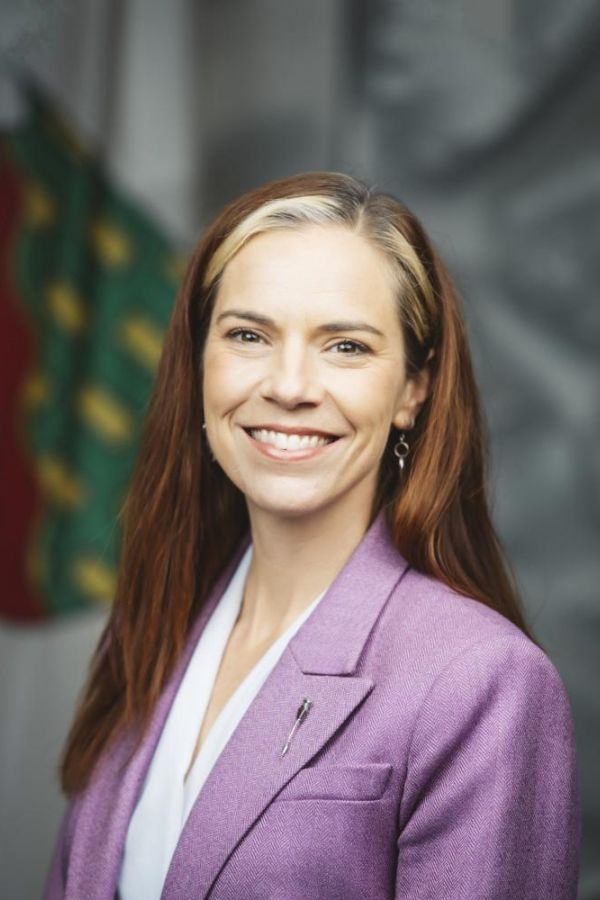Question.

Question has been called. All those in favour? All those opposed? All those abstaining? The motion is carried.
Carried
Member for Nunakput.
Committee Motion 350-19(2): Committee Report 39-19(2): Standing Committee on Economic Development and Environment Report on the Prevention and Management of Contaminated Sites – Alginment and Community-Based Monitoring and Surveillance Programs, Carried

Madam Chair, I move that the committee recommends that the Government of the Northwest Territories work interdepartmentally with communities and their existing communitybased monitoring programs to align monitoring efforts with the surveillance programs required under regulatory permits and licenses. Thank you, Madam Chair.

Thank you. The motion is in order. To the motion.
Question.

Question has been called. All those in favour? All those opposed? All those abstaining? The motion is carried.
Carried
Member for Nunakput.
Committee Motion 351-19(2): Committee Report 39-19(2): Standing Committee on Economic Development and Environment Report on the Prevention and Management of Contaminated Sites – Regulatory Decision-Making and Inspection Capacity, Carried

Madam Chair, I move that the committee recommends that the Government of the Northwest Territories ensure it has the internal expertise to inform regulatory decisionmaking and inspection capacity to prevent further public liabilities. Thank you, Madam Chair.

Thank you. The motion is in order. To the motion? Member for Frame Lake.

Thanks, Madam Chair. Yes, I want to make sure that we have some very hardworking enforcement staff in place now, and I want to make sure that this is not perceived in any way as a criticism of the work that they do. What this is, is a reflection of findings from the environmental audit that took place in 2020 that wanted you know, that pointed out that we want to make sure that there's an adequate inspection, and I'm going to quote here, "ensuring adequate inspection capacity as well as timely and transparent inspections, reporting, and follow up." So in no way is this is a criticism of our hardworking enforcement staff. They have a very difficult job, sometimes, of trying to work with operators and so on. And I certainly appreciate their hard work. But we want to make sure that they have the resources to do the work that needs to get done and that the public is not placed at risk of any kind of assuming further liabilities.
And there was a case recently highlighted in the media in Norman Wells where some dust rail debris, I guess is probably the nicest way to call it, was accumulated on a private property and or at least leased property, and nothing was really done about it. And now the town kind of left with trying to clean up these leased lands within their boundaries because nothing was really done about this. So in any event, this is about making sure that there's adequate capacity, resources for the people that know how to do the job to actually get it done, and to do it well to prevent further public liability. So I just wanted to make that clear, Madam Chair. Thank you.

Thank you. To the motion?
Question.

Question has been called. All those in favour? All those opposed? All those abstaining? The motion is carried.
Carried
Member for Nunakput.
Committee Motion 352-19(2): Committee Report 39-19(2): Standing Committee on Economic Development and Environment Report on the Prevention and Management of Contaminated Sites – Expansion of Approach to Contaminated Sites Guidance Document, Carried

Thank you, Madam Chair. The committee recommends that the Government of the Northwest Territories expand the Approach to Contaminated Sites guidance document to ensure policies and processes are in place to prevent future public and environmental liabilities, most significantly projects that result in perpetual care situations; and further, that the policy and guidance with respect to public disclosure are also required. Thank you, Madam Chair.

Thank you. The motion is in order. To the motion. Member for Frame Lake.

Thanks, Madam Chair. I'm just going to speak to this quickly. This document, Approach to Contaminated Sites, I think is only about 12 or 13 pages. In the last Assembly, where it was actually a mandate item do some work on this, we were promised a policy binder. Never got it. And promised a policy binder again in this Assembly. Never got anything. Nothing's been done in terms of actual policy work by our government. No legislative change, no regulatory change, no policy work other than this 12/13page document. We got to do better. And that's what this is aimed at, Madam Chair. And I think many of the recommendations here, just roll them up, put them into a policy, Mr. Minister, and we start to actually get a better approach to prevent public liabilities from contaminated sites. Thanks, Madam Chair.

Thank you. To the motion? Member for Yellowknife North.

Yes, thank you, Madam Chair. I just want to also emphasize that industry has long asked for a number of these policies too, because they find themselves in confusing situations. There's been a longtime ask for a brown field policy site. And I think also some direction needs to be given on when, you know, a mine's going to be allowed to leave infrastructure, if at all, on a site. I don't think those are best to kind of just be made oneoff kind of ministerial decisions. But there should be some proper policy.
And similarly, there's a motion in here about, you know, relinquishment. We similarly don't have kind of a clear guidance on when we will finally, you know, take on a site and that mine and that company no longer has any obligations towards it. And there's a number of ways to look at that. But, you know, we've made a lot of improvements to our regulatory system. I think the land and water boards are operating better than they ever had. But they're not in the position to make those large government policy decisions on when the GNWT, at the end of the day, is going to, you know, take some sort of risk or take on a site and where exactly that line is. And, you know, we are going to, as committee, hopefully meet with the diamond mines and the ones that are going through their first closure. But we haven't done this before, and we certainly haven't done it as our government on the scale of the diamond mines are going through, and we need some certainty. The boards need some certainty; the companies need some certainty; and so do the taxpayers. So there is a lot of policy work that needs to be done. Thank you, Madam Chair.

Thank you. To the motion.
Question.

Question has been called. All those in favour? All those opposed? All those abstaining? The motion is carried.
Carried
Member for Nunakput.
Committee Motion 353-19(2): Committee Report 39-19(2): Standing Committee on Economic Development and Environment Report on the Prevention and Management of Contaminated Sites – Early Warning System to Prevent Liabilities, Carried

Madam Chair, I move that the committee recommends that the Government of the Northwest Territories establish an internal capacity for an effective early warning system to prevent further public liabilities; and further, this approach will also require clear measures to prevent perpetual care situations, including mandatory financial security that is regularly reviewed and adjusted. Thank you, Madam Chair.

Thank you. The motion is in order. To the motion.
Question.

Question has been called. All those in favour? All those opposed? All those abstaining? The motion is carried.
Carried
Member for Nunakput.
Committee Motion 354-19(2): Committee Report 39-19(2): Standing Committee on Economic Development and Environment Report on the Prevention and Management of Contaminated Sites –Remediation and Reclamation Timelines, Carried

Thank you, Madam Chair. I move that the committee recommends that the Government of the Northwest Territories ensure legislation has clear and appropriate timelines for remediation and reclamation of inactive or suspended well sites. Thank you, Madam Chair.

Thank you. The motion is in order. To the motion.
Question.

Question has been called. Member for Yellowknife North.

Yeah, thank you. I just want to speak a little bit on behalf of the chair. You know, he's got some sumps in Nunakput that are approaching the end of their life, and they're sitting there, and those oil companies are just hanging on to them and they're not remediating them because they don't want to put the money in. And as long as they just hold on to them, the GNWT, it's not their asset, they can't really do much, so. I think we really ought to revisit that and not let those get to the point where they're literally falling into the ocean in some case. And right now we don't seem to have the tools to correct that situation. Thank you, Madam Chair.

Thank you. To the motion?
Question.

Question has been called. All those in favour? All those opposed? All those abstaining? The motion is carried.
Carried
Member for Nunakput.
Committee Motion 355-19(2): Committee Report 39-19(2): Standing Committee on Economic Development and Environment Report on the Prevention and Management of Contaminated Sites – Northwest Territories Model of Saskatchewan Institutional Control Program, Carried

Thank you, Madam Chair. I move that the committee recommends that the Government of the Northwest Territories study the government of Saskatchewan Institutional Control Program and develop a Northwest Territories model that better implements the polluter pays principle for the long term and unforeseen remediation of mining sites while providing regulatory certainty with respect to industry relinquishment; and further, that the Northwest Territories model should be developed by the end of the 19th Legislative Assembly. Thank you, Madam Chair.

Thank you. The motion is in order. To the motion? Member for Frame Lake.

Yes, thanks, Madam Chair. I just want to highlight what this institutional control program is all about.
In Saskatchewan, the mining that takes place is generally in the northern part of the province. They've got a bunch of abandoned uranium mines there that I guess were federally owned, operated, or regulated and so on; a few gold mines here and there too, but. So they had this problem of these abandoned mines and no way of really trying to deal with them or find funding and so on. So what they did was they thought long and carefully about this, and they talked to people in the mining industry as well. The mining industry wants to get some certainty about when they can walk away from a site after using it. And that's not an unreasonable thing. You know, they'd go in, use an area, and they want to know when they're clear and free.
So what they the Saskatchewan government did was ask companies if you're going to leave a site, mining companies, there's two pots of money that you can and should be paying into. The first one is to kind of take care of ongoing maintenance care and maintenance at the site. Things like, you know, you might have to do a geotechnical inspection every few years of openings that have been closed or dam structures that have been left on site that, you know, tailings covers, to make sure that they're still working the way that they're supposed to. So those kind of ongoing care costs, you know, that money can be put into one pot.
A second pot, though, is to really deal with unforeseen events, like Mount Polley in British Columbia, where there was a catastrophic tailings failure and tailings went all the way down into Quesnel Lake, polluted salmonbearing waters what a mess. So, you know, there's some risk associated with those with some sites, so companies that are at high risk sites, they can put some money into an unforeseen events pot of money and then the government can access that to take care of, you know, potentially, you know, unforeseen catastrophic events.
Now this is a pretty new system in Saskatchewan. It's only been in place for I think less than a decade, and there's only two or three companies that are maybe three or four, that are in this program. But at least somebody's thought it through as a way for the government to actually have money in place to deal with sites and operators can then walk away and leave it, and they don't have to worry about the liability associated with these sites. And, you know, when you think about some of these sites, they're going to be here hundreds of years into the future. Where are the resources going to come from to manage them in a collective sense? So at least the Government of Saskatchewan has thought this through; they have a system in place. We have got nothing for Giant Mine, quite frankly, other than the environmental agreement that does I think start to look at some of this perpetual care plan that's going to have to be generated. But as a government that wants to promote responsible resource development, we have a duty to come up with a system that's going to allow industry to have clear and free knowing when relinquishment's going to take place and walk away but some public confidence that there's still resources that can look after sites for the regular care and maintenance and unforeseen events. And that's the beauty of this system. But we've got nothing. And I don't know what's happening within the departments to actually look at this issue. So I'll be very curious to see how the Cabinet responds to this recommendation. Thanks, Madam Chair.

Thank you. To the motion?
Question.

Question has been called. All those in favour? All those opposed? All those abstaining? The motion is carried.
Carried
Member for Nunakput.
Committee Motion 356-19(2): Committee Report 39-19(2): Standing Committee on Economic Development and Environment Report on the Prevention and Management of Contaminated Sites – Departmental Coordination of Securities, Carried

Thank you, Madam Chair. Madam Chair, I move that the committee recommends that the Government of the Northwest Territories implement transparent and clear processes to ensure that securities are established, reviewed, and coordinated among various departments. Thank you, Madam Chair.

Thank you. The motion is in order. To the motion? Member for Frame Lake.

Madam Chair, I'm going to speak to this quickly. We have at least three pieces of legislation maybe two I guess, that where financial security requirements can be placed on an operator or mine owner, oil and gas operation I guess if we include oil and gas, maybe three or four different pieces of legislation. So the Department of Environment and Natural Resources has the Waters Act and they can ask for or through that process, financial security for waterrelated use and an infrastructure site can be requested. And there's the Lands Act, Northwest Territories Lands Act for landsrelated stuff. And then for oil and gas, you can have other provisions for financial security. And this is not set in stone. You know, what's land? What's water related? Is a tailings dam a land feature; is it a waterrelated feature? And how is that covered and coordinated between these two types of financial securities that could be requested? There's no arrangement for this to happen other than the land and water boards by practice have said give us one closure plan, we'll figure out what the liability is and we'll recommend a global figure. But even some of the figures that they've submitted with their draft licenses haven't been acceptable to our government because they can't figure it out or they don't know they don't want to hold security under one act when it should be for another act. This has got to be sorted out because what it does is it puts the public at risk that we're going to assume more liability in the future. So that's what this recommendation is aimed at. Maybe having a combined department as of April 1st will help resolve a bit of this, but it's also a legislative problem. But it could be solved through a memorandum of understanding or some way of dealing with this better. But what we have in place is causing confusion, double bonding possibly, even or you know, for operators or mine owners that's not fair to them. This stuff has got to get sorted out, and I'll look forward to how Cabinet's going to respond to this one as well. Thanks, Madam Chair.

Thank you. To the motion.
Question.







